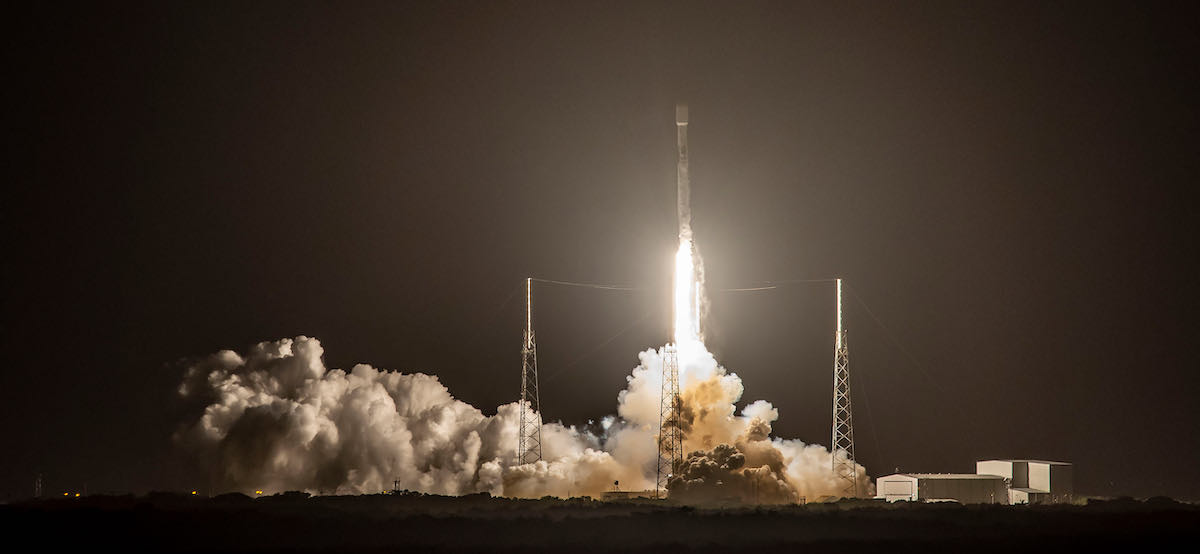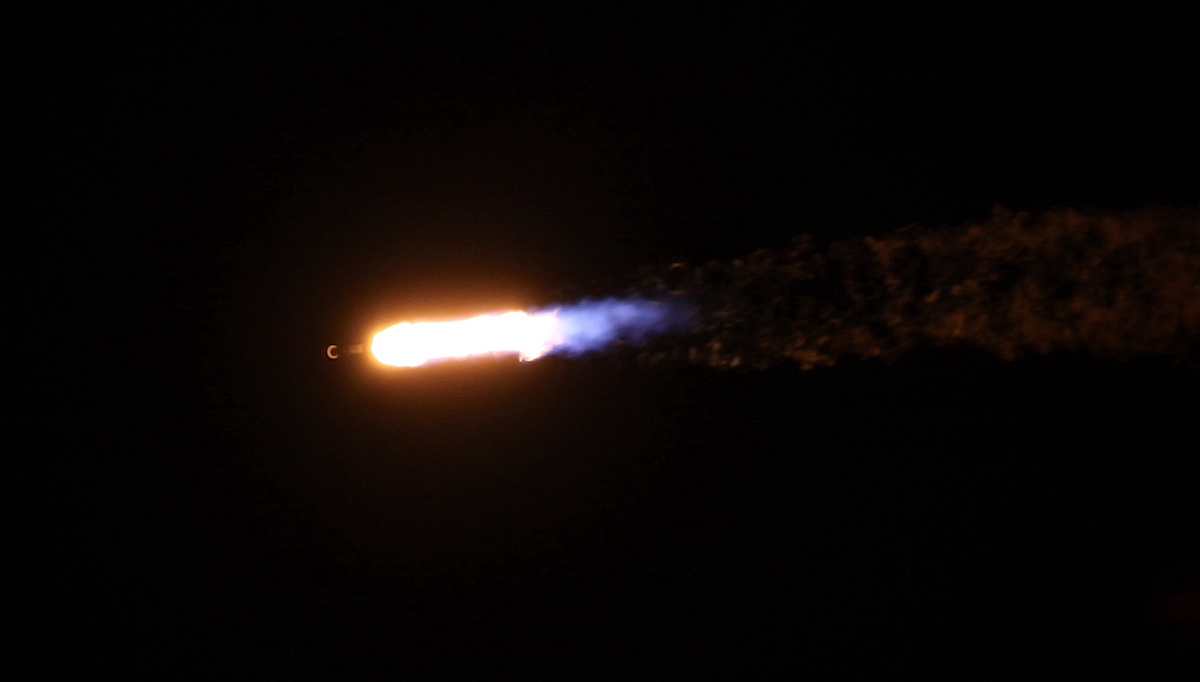SpaceX deployed 60 more Starlink internet-beaming spacecraft into orbit after a fiery late-night blastoff of a Falcon 9 rocket Wednesday night from Cape Canaveral, surpassing the 1,500-satellite mark since Starlink launches began. Another Falcon 9 rocket is scheduled to haul the next batch of Starlink satellites to space next week.
The launch of the newest 60 Starlink satellites came soon after the Federal Communications Commission on Tuesday approved a SpaceX request to fly the rest of the company’s near-term Starlink spacecraft at lower altitudes.
SpaceX deployed the 60 quarter-ton Starlink satellites about an hour after they lifted off from pad 40 at Cape Canaveral Space Station at 11:44 p.m. EDT Wednesday (0344 GMT) Thursday.
The 229-foot-tall (70-meter) Falcon 9 rocket soared into a clear night sky over Florida’s Space Coast, blazing a trail to the northeast over the Atlantic Ocean to align with the Starlink network’s orbital geometry. Nine kerosene-fed Merlin 1D engines on the Falcon 9’s first stage booster produced 1.7 million pounds of thrust in the first two-and-a-half minutes of flight.
Then the Falcon 9’s booster shut down and separated, beginning maneuvers aided by cold gas thrusters, grid fins, and engine retro-burns to land on SpaceX’s drone ship “Just Read the Instructions” in the Atlantic Ocean a few hundred miles east of Charleston, South Carolina.
The reusable booster’s on-target landing concluded the rocket’s seventh trip to space and back since debuting last June. It was the 81st successful recovery of a Falcon rocket booster since SpaceX’s first rocket landing in 2015.
The Falcon 9 rocket’s second stage engine continued the mission into orbit, delivering the 60 Starlink payloads to a preliminary parking orbit less than 10 minutes into the mission. After soaring across the Atlantic, traversing Europe and the Middle East, and flying over the Indian Ocean, the second stage’s single Merlin engine reignited for a brief one-second firing to nudge the Starlink satellites into the proper orbit for separation.
The stack of 60 Starlink satellites, which weighed some 34,400 pounds (15.6 metric tons) on the launch pad, flew free of the rocket at 12:49 a.m. EDT (0449 GMT), wrapping up SpaceX’s 115th Falcon 9 launch since 2010, and the 12th this year.
SpaceX is gearing up for another launch next week carrying the next group of Starlink satellites. A Falcon 9 rocket is scheduled for liftoff from pad 39A at NASA’s Kennedy Space Center next Tuesday, May 4, at 3:01 p.m. EDT (1901 GMT).

The flat-panel satellites, built on SpaceX’s Starlink assembly line in Redmond, Washington, will unfurl their solar panels and switch on krypton ion thrusters to begin raising their orbits from their deployment altitude of 180 miles (291 kilometers) to join the rest of the Starlink constellation at 341 miles (550 kilometers) above Earth.
With this launch, SpaceX has delivered 1,505 Starlink satellites to space, including prototypes and failed spacecraft that have dropped out of orbit and burned up in the atmosphere. Jonathan McDowell, an astronomer and expert tracker of spaceflight activity, says 1,374 Starlink satellites are currently in orbit, not counting the 60 spacecraft launched Wednesday night.
The Federal Communications Commission has authorized SpaceX to deploy some 12,000 Starlink satellites operating at Ku-band, Ka-band, and V-band frequencies, and at a range of altitudes and inclinations in low Earth orbit. The satellites are already beaming low-latency, broadband signals to users who have signed up for Starlink beta testing.
The FCC announced Tuesday it had granted a request by SpaceX to modify the structure of its Starlink fleet.
So far, nearly all of the Starlink satellites launched by SpaceX operate in 341-mile-high orbits tilted at an inclination of 53 degrees to the equator.
“We do have global reach but we don’t have full connectivity globally,” said Gwynne Shotwell, SpaceX’s president and chief operating officer, at an industry conference earlier this month. “We hope after about 28 launches, we’ll have continuous coverage throughout the globe. And then the plan after that is to continue to add satellites to provide additional capacity.”
The launch Wednesday night was the 24th Falcon 9 flight dedicated to hauling operational Starlink satellites, known as Version 1.0, into orbit, and the 27th Falcon 9 mission overall with Starlink payloads on-board.
Last April, SpaceX requested approval from the FCC to operate its Starlink satellites at lower altitudes than initially planned, all between 335 miles (540 kilometers) and 354 miles (570 kilometers).
SpaceX said the change in altitude would reduce latency of internet signals and allow the company to build out its network more quickly. The company pitched the proposed change as also enabling improved internet connectivity over polar regions, a capability desired by the U.S. military, and reducing the risk that dead or failed satellites might become a long-term source of space junk.

Starlink competitors, such as Viasat and representatives from Amazon’s planned Kuiper network, objected to SpaceX’s request to fly its satellites at lower altitudes. The companies claimed the change would increase the Starlink fleet’s interference with other spacecraft, and create more congestion at an already-populated orbital altitude, or shell.
The FCC dismissed the objectives, ruling that the changes proposed by SpaceX served the public interest.
“Our action will allow SpaceX to implement safety-focused changes to the deployment of its satellite constellation to deliver broadband service throughout the United States, including to those who live in areas underserved or unserved by terrestrial systems,” the FCC wrote in its ruling.
With the commission’s approval, SpaceX will now operate its first 4,408 satellites at altitudes between 335 miles and 354 miles, instead of flying more than 2,800 of the spacecraft in orbits as high as 800 miles, or 1,300 kilometers, above Earth.
SpaceX officials and astronomy groups said the placement of Starlink satellites in lower orbits reduces their impacts on ground-based telescopic observations. SpaceX has darkened the coatings on its satellites after scientists complained that sunlight reflected off the spacecraft surfaces might ruin some astronomical research.
The FCC approval clears the way for SpaceX to start launching more Starlink satellites into polar orbit later this year. The polar orbiting satellites will give the Starlink network complete global coverage.
The updated Starlink network architecture has 1,584 satellites at 341 miles (550 kilometers) altitude and an inclination of 53 degrees, 1,584 satellites at 335 miles (540 kilometers) and an inclination of 53.2 degrees, 720 satellites at 354 miles (570 kilometers) and an inclination of 70 degrees, and 520 satellites at 348 miles (560 kilometers) and an inclination of 97.6 degrees.
SpaceX still has regulatory authorization to launch more than 7,000 additional Starlink satellites beyond the 4,408 spacecraft covered in the recent FCC approval.
Email the author.
Follow Stephen Clark on Twitter: @StephenClark1.